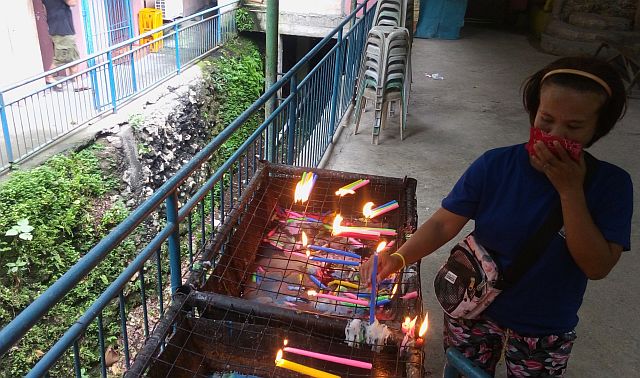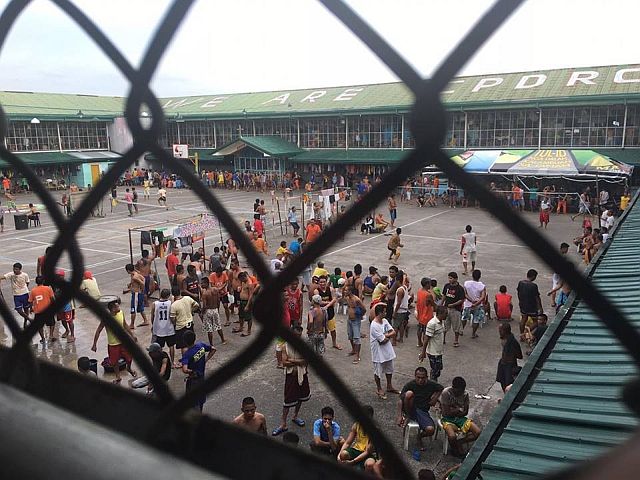FINDING THE CULPRIT

The foul odor coming from the Kalunasan Creek prompts a devotee of the Our Lady of Guadalupe de Cebu to cover her nose while offering candles and petitions at the Langub Shrine to avoid the dizzying stench. (CDN PHOTO/TONEE DESPOJO)
Whose poop is it?
The question appears to have no answer for now, as Cebu’s biggest jails, the Cebu City Jail and the Cebu Provincial Detention and Rehabilitation Center (CPDRC), began throwing blame at each other on why human feces have made their way through Kalunasan creek, just 50 meters beneath the two facilities.
The situation has prompted Cebu Gov. Hilario “Junjun” Davide III to call for an investigation of the jails by the Bureau of Jail Management and Penology (BJMP) for Cebu City Jail and the Provincial Engineering’s Office (PEO) for CPDRC.
The Environmental Management Bureau (EMB-7) of the Department of Environment and Natural Resources in Central Visayas (DENR-7) also sent a team to Barangay Kalunasan on Monday to take water samples from the creek.
Situated atop the mountain village, CPDRC and Cebu City Jail have both been painted by residents and barangay officials as the culprits for the repugnant odor that reeks through the creek.
They claimed that waste from the jails’ overfilled septic tanks are thrown into the waterway that traverses several households and structures, including Cebu’s most iconic grotto, the sacred Langub Shrine of Cebu’s patroness, the Our Lady of Guadalupe de Cebu.
On Sunday, a resident, 60-year-old Sophia Canoog went as far as storming the city jail to complain against the stench which had gotten worse over time, making it difficult for people in the area to breathe without inhaling the smell of human waste.
Canoog, who has stormed the jail facilities several times before, said that she was now certain that Cebu City Jail was to blame for alleged dumping sewage into the nearby creek.
She had gotten wind of this information from a city jail insider, she said.
“Ikapila na nako na sila gisulong. Gahapon (Sunday) lang, giadto na nako sila, kanang female dormitory kay akong giingnan ayaw sa na ihabwa ilahang mga hugaw diha kay pista karon, respeto na lang sa Birhen (I’ve stormed them many times before; but last Sunday, I went to the female dormitory and told them not to throw their wastes today since it was the fiesta. They should do it out of respect for the Virgin),” Canoog told Cebu Daily News.

The Cebu Provincial Detention and Rehabilitation Center. (CDN FILE PHOTO)
Sought for comment, Cebu City Jail warden Supt. Jessie Calumpang strongly denied that they were responsible for the creek’s pollution and passed the blame on to the neighboring CPDRC.
“CPDRC na, dili kami (That would be CPDRC, not us),” said Calumpang, adding that it has never been their practice to dispose of septic wastes into the water channel.
He then challenged the public to check on the jail facility and the condition of their septic tanks.
“Ako inviton ang mga nagreklamo ug ipasubay dire sa mga jail kinsa gyud ang tig-release og hugaw gikan sa septic tank og mag-ulan (I am inviting those who are complaining to investigate the jails here to determine who really has the practice of releasing wastes from their septic tank into the creek when it rains),” Calumpang said.
Both the Cebu City Jail, managed by the Bureau of Management and Penology (BJMP), and the CPDRC, run by the Cebu provincial government, are filled way beyond their capacity.
CPDRC, which was built for 1,600 people, now houses 2,890 detainees; while Cebu City Jail, intended for only 2,000 prisoners, currently has 3,797 inmates.
Congested
CPDRC acting warden Dr. Gil Macato vehemently belied Calumpang’s allegation, saying that it has never been a practice of the provincial jail to unload the contents of the facility’s septic tanks into the creek.
In fact, people in the area know that such was a Cebu City Jail practice, Macato said.

The number of inmates at the Cebu Provincial Detention and Rehabilitation Center (CPDRC) has reached 3,012 as of yesterday, which is 100 percent more than the minimum capacity of 1,500. (CDN PHOTO/JOSE SANTINO BUNACHITA)
“That allegation no, dili na sa amoa nga practice. Nasayod ang mga naa dinhi nga inig ulan, ipakuyog nila ang hugaw, sa pikas na sa Cebu City jail (That is not our practice. People here know that when it rains, the Cebu City jail does that),” Macato said.
Macato added that the jail’s congestion never posed a problem when it came to disposing of the facility’s septic wastes.
“Di sad ta ka ingon nga tungod daghan mi og inmates maong di ka-accommodate ang among septic tank. Dili na mao, kay okay pa among septic tank. (It does not follow that just because there are several inmates here, our septic tank could no longer accommodate. Our septic tank is still okay),” said Macato, adding that the tank is even treated with chlorine to kill bacteria.
Over at the Cebu City Jail, Calumpang said that renovations of the septic tank are underway so that it could accommodate more waste.
Davide and EMB investigations
Sought for comment, Davide said that while he believed that the accusations against CPDRC were unfair, he will still ask provincial engineers to check on the provincial jail facility.
Davide likewise called on BJMP to do the same for Cebu City Jail.
“It’s not fair. Kana diay hugaw sa laing jail naa diha? Kanang mga kabalayan diha, naa man daghan balay diha (How about the wastes coming from the other jail there? How about the households in the area?)” asked Davide.
“So it’s not fair if they are blaming only the CPDRC,” the governor added.
Meanwhile, EMB-7 Director William Cuñado sent a technical team yesterday morning to Barangay Kalunasan to check on the creek’s level of contamination.
Cuñado refused to issue any statements pending laboratory results of the water samples taken from the creek.
A team from EMB will also be sent to the CPDRC and Cebu City Jail today to check on the condition of the jails’ sewerage systems.
“They will check the condition of the waste water treatment facilities in both jails,” Cuñado told CDN while he refused to comment on the CPDRC-Cebu City Jail “whose poop is it” debate.
“Let’s just wait for the results. I don’t want to buy their opinions,” he said.
Disclaimer: The comments uploaded on this site do not necessarily represent or reflect the views of management and owner of Cebudailynews. We reserve the right to exclude comments that we deem to be inconsistent with our editorial standards.
